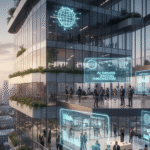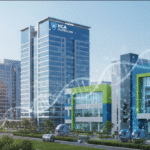Now Reading: How India GCCs Are Transforming Retail/CPG – NASSCOM-ANSR
-
01
How India GCCs Are Transforming Retail/CPG – NASSCOM-ANSR

How India GCCs Are Transforming Retail/CPG – NASSCOM-ANSR
ScaleGCC Editorial TeamInsights3 months ago676 Views
India GCCs (Global Capability Centers) have shifted from mere cost-saving hubs to strategic innovation engines for Retail/CPG companies. They now drive digital transformation, own end-to-end processes, and build advanced capabilities in AI, analytics, and automation. Leading GCCs in Bengaluru and other cities foster hybrid talent models and partner with start-ups to scale niche expertise. This evolution underscores why How India GCCs Are Transforming Retail/CPG, they’re essential levers for growth and competitive advantage.
"India hosts the Global Capability Centers for roughly 25% of the world’s leading Retail and CPG companies, collectively employing over 50,000 professionals"
Strategic Recommendations for GCC Operations
To unlock the full strategic potential of India-based GCCs, companies should begin by empowering these centers with end-to-end ownership of critical processes. Rather than limiting GCCs to transactional work, assign them accountability for global product modules or business functions Tesco’s TBS, for example, manages over £4 billion in payroll and finance processes, delivering a 3.5× return on its operating cost through continuous improvement. Next, invest heavily in emerging technologies: survey data shows that 90% of Retail/CPG GCCs already build AI/ML, RPA, and analytics capabilities, so new centers should staff dedicated data-science and automation teams from day one.
Embrace a hybrid talent model, combining a core in-house team with third-party specialists; 91% of GCCs use service providers to accelerate niche skills, as seen in Falabella India’s boutique-partner approach. Finally, foster a culture of outside-in innovation by launching accelerator programs or hackathons that bring start-ups into your GCC’s ecosystem Target’s Bangalore accelerator has already co-developed multiple retail solutions, demonstrating how structured start-up partnerships can yield customer-facing innovations rapidly.
Trends and Future Outlook for Retail/CPG GCCs
The Retail/CPG GCC segment in India is on a steep growth trajectory: more than 50% of all centers were established between 2016 and 2020, and an estimated 80% of the top 100 global Retail/CPG firms planned to set up an India GCC by 2022. Moving forward, GCCs will increasingly function as “twin” organizations alongside headquarters, with 70% already hosting global functional leaders on-site to drive P&L and product decisions.
Technological investment priorities are clear: AI/ML, automation, and advanced analytics top the list, with cybersecurity and cloud platforms following closely. GCCs will double down on digital commerce, IoT, and AR/VR innovations to support omnichannel retail experiences. Collaboration with start-up ecosystems will deepen, making GCCs the R&D engine for future retail models. Ultimately, these centers will remain a permanent strategic pillar, enabling companies to scale digital transformation and maintain competitive advantage in an increasingly technology-driven industry.
| Key Finding | Statistic & Insight |
|---|---|
| GCC Evolution Beyond Cost | • 80% of top 100 global Retail/CPG firms planned India GCCs by 2022• GCCs now drive digital, analytics, and innovation capabilities vs. just cost arbitrage |
| Rapid Growth & Scale | • 50% of Retail/CPG GCCs in India established between 2016–2020• India hosts ~25% of all global Retail/CPG GCCs, employing 50,000+ professionals |
| Broad Functional Scope | • 90% of centers build digital/technology (AI/ML, RPA, analytics) capabilities• 60–70% support core retail (merchandising, supply chain) and corporate (finance, HR) functions |
| Hybrid Operating Models | • 91% of GCCs leverage third-party service providers alongside captive teams• Hybrid mix accelerates niche skills and scalability (e.g., Falabella’s boutique-partner model) |
| Innovation via Start-up Ecosystems | • ~50% of GCCs run accelerators or startup partnerships• Centers like Target use India labs to co-develop retail solutions via hackathons and accelerators |
| Location & Leadership | • Bengaluru houses 70% of Retail/CPG GCCs; Hyderabad, Pune, Chennai emerging• ~70% of centers have global functional leaders on-site as “second headquarters” |
| Future-Ready Outlook | • GCCs will increasingly “twin” HQ, owning P&L and product leadership• Continued investments in AI, advanced analytics, cybersecurity, and omnichannel platforms |
Case Study Summaries
Let me try to give you the actual view with the case studies below.
Tesco Business Services (TBS): Established in 2004 in Bengaluru, TBS has grown to over 4,000 employees managing global finance processes (FP&A, R2R, P2P) and store operations design. By adopting design thinking and digital interventions, TBS unlocked a 3.5× return on its operating cost and delivers continuous improvements that serve Tesco’s 6,800 stores worldwide.
Falabella India: Launched in 2018 with ~200 staff, Falabella India leverages a hybrid model combining top local hires with boutique consulting partners to build digital platforms for one of Latin America’s largest retailers. Its accelerator program, Falabella Exceed, sources innovative solutions from start-ups, driving 124% growth in home deliveries and 6.6× online GMV growth in 12 months.
Opportunities and Benchmarks for New or Scaling GCCs
For organizations planning to establish or expand their Retail/CPG GCCs, India’s ecosystem presents compelling opportunities. Begin in Bengaluru to tap into a talent pool that supports 70% of existing GCCs, then consider satellite offices in Hyderabad or Pune for cost diversification and access to emerging tech clusters.
Benchmark your center’s growth against industry averages new GCCs typically reach 500-1,000 employees within three years and expand from tech into 3-4 additional functional domains (finance, supply chain, marketing). Track innovation metrics such as the number of start-up partnerships (industry leaders average 5+ active accelerator collaborations) and pilot-to-production turnaround times (top GCCs average 3-6 months). To attract and retain talent, offer a strong employer value proposition with flexible work practices (adopted by over 50% of GCCs) and clear career pathways. By measuring these benchmarks and iterating on your hybrid talent and innovation models, new and scaling GCCs can achieve strategic impact and position themselves as engines of transformation for the enterprise.
Walmart vs. Target (Comparative Highlights)
Here is an another interesting comparison of 2 major US retail companies.
Every day, India’s GCC teams are proving that remote hubs can feel like home for innovation and collaboration. By blending local talent with global vision whether through creative partnerships, spot-on data insights, or a shared cup of chai during a late-night brainstorming session these centers aren’t just saving costs; they’re rewriting the story of what it means to drive change. As they grow alongside their headquarters, India GCCs will continue to surprise us with fresh ideas, strong partnerships, and a relentless drive to make retail and CPG experiences better for everyone.
Disclaimer:
This blog is based on insights and data published in the “Evolution of Retail / CPG
GCCs in India” by NASSCOM and ANSR. All facts, statistics, and projections referenced herein are attributed to the original report unless otherwise noted. The blog is intended for informational purposes only and does not represent the views of NASSCOM and ANSR. Readers are encouraged to consult the original report for comprehensive analysis and context.
Stay Informed With the Latest & Most Important News
Previous Post
Next Post
Interesting Read
Tools3 months ago
GCC Location Feasibility Assessment Tool
Tools1 month ago
Tech Skills Readiness Analyzer
Tools3 months ago
GCC Setup Costs - TCO & ROI Calculator
Tools5 days ago
GCC Vendor Evaluation Framework














